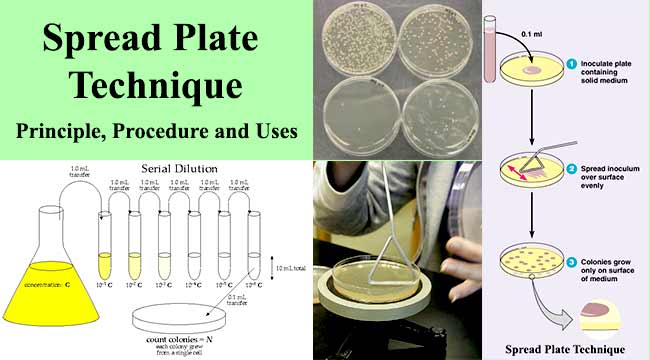Spread plate technique is the method of isolation and enumeration of microorganisms in a mixed culture and distributing it evenly. The technique makes it easier to quantify bacteria in a solution.
Principle of Spread Plate Technique
The spread plate technique involves using a sterilized spreader with a smooth surface made of metal or glass to apply a small amount of bacteria suspended in a solution over a plate. The plate needs to be dry and at room temperature so that the agar can absorb the bacteria more readily. A successful spread plate will have a countable number of isolated bacterial colonies evenly distributed on the plate.
Procedure of Spread Plate Technique
- Make a dilution series from a sample.
- Pipette out 0.1 ml from the appropriate desired dilution series onto the center of the surface of an agar plate.
- Dip the L-shaped glass spreader into alcohol.
- Flame the glass spreader (hockey stick) over a Bunsen burner.
- Spread the sample evenly over the surface of agar using the sterile glass spreader, carefully rotating the Petridish underneath at the same time.
- Incubate the plate at 37°C for 24 hours.
- Calculate the CFU value of the sample. Once you count the colonies, multiply by the appropriate dilution factor to determine the number of CFU/mL in the original sample.
Uses of Spread Plate Technique
- It is used for viable plate counts, in which the total number of colony forming units on a single plate is enumerated.
- It is used to calculate the concentration of cells in the tube from which the sample was plated.
- Spread plating is routinely used in enrichment, selection, and screening experiments.
Limitations of Spread Plate Technique
- Strick aerobes are favored while microaerophilic tends to glow slower.
- Crowding of the colonies makes the enumeration difficult.
References
- M. J. Pelczar
- Mackie and McCartney. Practical Medical Microbiology
- Bailey & Scott’s Diagnostic Microbiology.
- Practical Microbiology. Pradeep Kumar Sharma.
- https://www.reference.com/science/spread-plate-technique-a3da655650023683#
- https://www.micro.iastate.edu/video/microbiology-004-spread-plate-method
- https://www.ncbi.nlm.nih.gov/pmc/articles/PMC3577269/
- https://www.jove.com/video/3064/aseptic-laboratory-techniques-plating-methods
- https://www.pinterest.com/pin/506232814336422077/
Similar Posts:
- Benedict’s Test- Principle, Composition, Preparation, Procedure and Result Interpretation
- Salmonella Shigella (SS) Agar- Composition, Principle, Uses, Preparation and Result Interpretation
- Negative Staining- Principle, Reagents, Procedure and Result
- List of culture media used in microbiology with their uses


Can you describe a particular situation where the result of this test is used in decision- making?
From various dilutions how can we get the one value of CFU/ml for one sample.
And how we expressed ecolicfu/ml